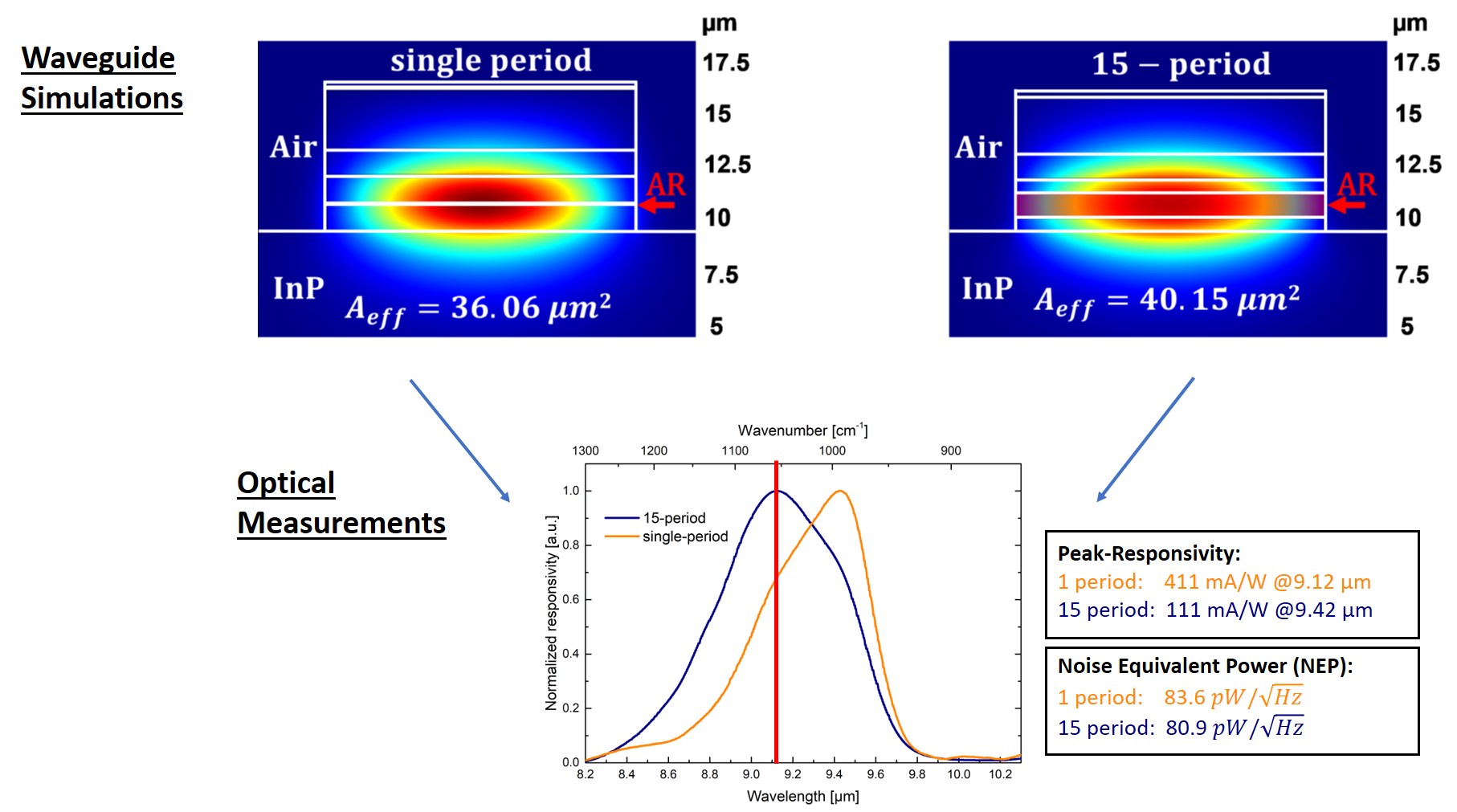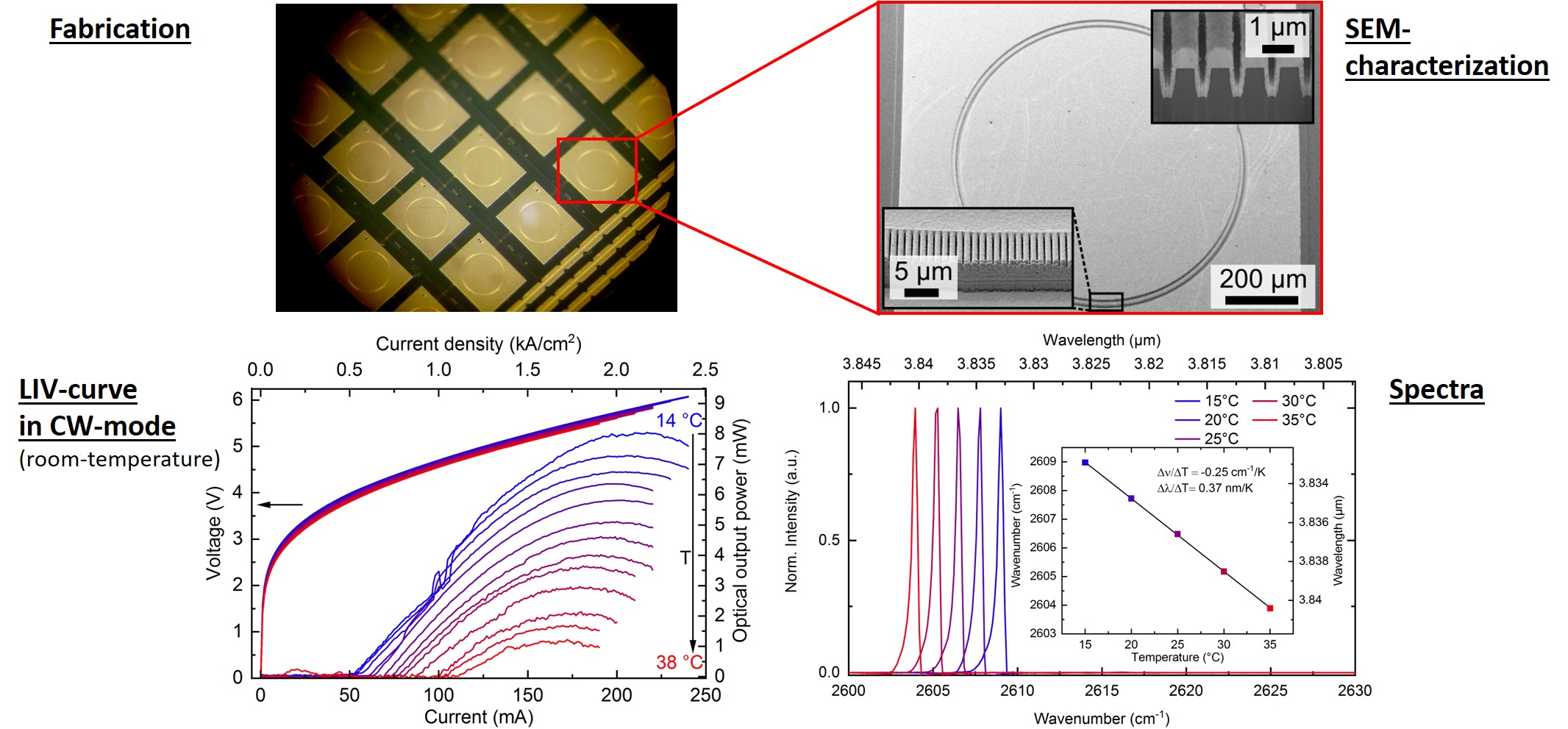Active optoelectronic devices
Research on Active Optoelectronic Devices
Active opteoelectronic devices, are semiconductor based devices that need external bias for their operation or generate a bias/current that can be extracted and analyzed. Diode lasers (emitters) and photodiodes (detectors) are typical examples. We use quantum cascade or interband cascade devices to generate or detect mid-infrared-to-THz light through intersubband (quantum cascade) or interband (interband cascade with type-II („broken gap„) band alignment) devices.
1. Mid-IR Lasers & Detectors
Semiconductor lasers are the foundation of modern optoelectronic devices and play a crucial role in the realizationof photonic integrated cirucits (PICs) which combine various functionalities on the chip scale. Novel developments in the field of Quantum Cascade (QC) devices open the path towards monolithic PICs in the mid-IR based on QC structures that can emit and detect similar-wavelength light from the same active region and were demonstrated before: [1]. They are typically referred to as QC lasers and detectors or QCLDs and nowadays reach comparable performance to state-of-the-art regular QCLs [2]. We use those devices in the long-wavelength IR (LWIR) spectral region, to unlock further applications in mid-IR spectroscopy and free-space communication.
a. Novel long-wavelength QCLDs [3]
We currently work on the development and realization of novel QCLD devices that cover the wavelength range from 8 µm – 10 µm. This range is especially relevant for sensing applications (e.g. ) and covers a spectral window of atmospheric transparency, enabling mid-IR free space data transmission and telecommunication.
The following figures show a novel ~8 µm QCLD, where we compare and confirm the spectral overlap in laser emission and detection [3]:

b. High-performance long-wavelength QCDs [4]
QC detectors (QCDs) are devices that operate at zero external bias and thus show beneficial low-noise characteristics. This is combined with a large linear detection range and high saturation intensities and makes QCDs interesting mid-IR and THz detectors. Due to exploiting the same material system and identical active region desings, they are excellent candidates for on-chip integration based on maonolithic or heterogeneous concepts.
So far, QCDs often show a significant performance reduction in the long-wave infrared above ~8 µm wavelength.
In a novel study, we realize high-performance QCDs at 9.12 µm and above, based on a new active region design and show how the responsivity can be further increased, when reducing the number of active region periods. A throrough comparison between single- vs 15-period ridge-waveguide QCDs reveals the particular effects on the device performance [4]:

c. Surface-Emitting Ring Interband Cascade Lasers [7]
Interband Cascade Lasers (ICLs) are hybrid devices, combining the strong interband transitions in a type-II band alignment with the cascading structure of QCLs. Their significantly lower threshold current densities as compared to QCLs, makes them suitable for mobile applications, where bulky heat dissipation concepts like water cooling are hampering their applications.
In a work, aiming at realizing singlemode ICLs tailored for spectroscopic applications in gas sensing, we developed substrate-emitting ring cavity devices. As demonstrated previously with QCLs [5], ring cavities are beneficial due to their much lower beam divergence and circular emission farfield. This enables the use of cheap off-the-shelf optics for beam collimation. We were able to demonstrate the first continous-wave emitting ring-ICLs at room-temperature [6] which where fabricated in our group, using the TU Wien cleanroom facility ZMNS. The results of a typical device are shown in the following:

[1] B. Schwarz, P. Reininger, H. Detz, T. Zederbauer, A. M. Andrews, S. Kalchmair, W. Schrenk, O. Baumgartner, H. Kosina, and G. Strasser, Appl. Phys. Lett. 101, 191109 (2012).
[2] B. Schwarz, C. A. Wang, L. Missaggio, T. S. Mansuripur, P. Chevalier, M. K. Connors, D. McNulty, J. Cederberg, G. Strasser, and F. Capasso, ACS Photon. 4(5), 1225 – 1231 (2017).
[3] D. Koukola, G. Marschick, M. David, E. Arigliani, B. Schwarz, A. Dabrowska, B. Lendl, G. Strasser, and B. Hinkov, ÖPG Meeting 2022, Leoben, Austria, Sept. 26 – 30 (2022).
[4] G. Marschick, M. David, E. Arigliani, N. Opacak, B. Schwarz, M. Giparakis, A. Delga, M. Lagree, T. Poletti, V. Trinité, A. Evirgen, B. Gerard, G. Ramer, R. Maulini, J. Butet, S. Blaser,
A. M. Andrews, G. Strasser, and B. Hinkov, Opt. Express 30(22), 40188-40195 (2022).
[5] A. Harrer, R. Szedlak, B. Schwarz, H. Moser, T. Zederbauer, D. MacFarland, H. Detz, A. M. Andrews, W. Schrenk, B. Lendl, and G. Strasser, Sci. Rep. 6, 21795 (2016).
[6] R. Szedlak, J. Hayden, P. Martín-Mateos, M. Holzbauer, A. Harrer, B. Schwarz, B. Hinkov, D. MacFarland, T. Zederbauer, H. Detz, A. M. Andrews, W. Schrenk, P. Acedo, B. Lendl, and G. Strasser, Opt. Engineering 1, 011005 (2018).
[7] H. Knötig, B. Hinkov, R. Weih, S. Höfling, J. Koeth, and G. Strasser, Appl. Phys. Lett. 116, 131101 (2020).

